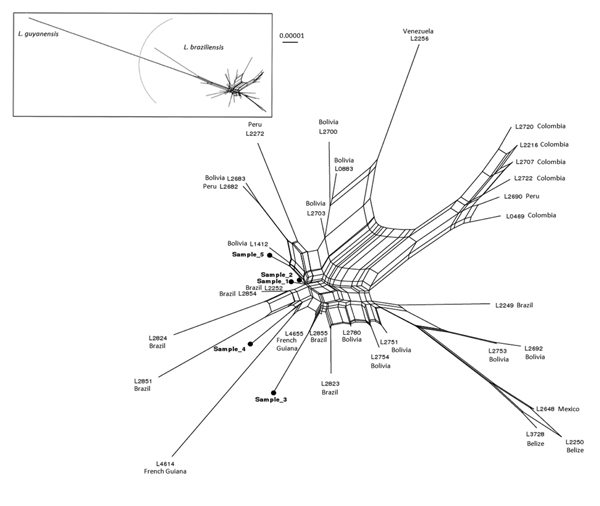Volume 21, Number 5—May 2015
Letter
Outbreak of Leishmania braziliensis Cutaneous Leishmaniasis, Saül, French Guiana
Figure

Figure. Data display network showing the genetic diversity of 32 Leishmania braziliensis (according to the multilocus enzyme electrophoresis–based taxonomy) compared with 5 strains from clinical samples (boldface) obtained from visitors to the Amazonian forest region of French Guiana. The strains were compared at 4 genomic loci (locus 03.0980, 10.0560, 31.0280 and 31.2610) as previously described (3). The concatenated nucleotide sequences (2,610 bp) were duplicated to avoid information loss due to heterozygous positions (e.g., A to AA or Y to CT). Neighbor-Net analysis was performed with SplitsTree version 4.11.3 (http://splitstree.org/) by using p-distances and equal edge lengths (4). Two L. guyanensis strains were used as an outgroup. The inset represents the genetic distance between L. guyanensis and L. braziliensis. Scale bar indicates evolutionary distance.
References
- Schwartz E, Hatz C, Blum J. New World cutaneous leishmaniasis in travellers. Lancet Infect Dis. 2006;6:342–9. DOIPubMedGoogle Scholar
- Desjeux P, Dedet JP. Isoenzyme characterization of 112 Leishmania isolates from French Guiana. Trans R Soc Trop Med Hyg. 1989;83:610–2. DOIPubMedGoogle Scholar
- El Baidouri F, Diancourt L, Berry V, Chevenet F, Pratlong F, Marty P, Genetic structure and evolution of the Leishmania genus in Africa and Eurasia: what does MLSA tell us. PLoS Negl Trop Dis. 2013;7:e2255. DOIPubMedGoogle Scholar
- Huson DH, Bryant D. Application of phylogenetic networks in evolutionary studies. Mol Biol Evol. 2006;23:254–67. DOIPubMedGoogle Scholar
- Krolewiecki AJ, Gil JF, Quipildor M, Cajal SP, Pravia C, Juarez M, Restricted outbreak of American tegumentary leishmaniasis with high microfocal transmission. Am J Trop Med Hyg. 2013;88:578–82. DOIPubMedGoogle Scholar
- Andrade MS, Brito ME, Silva ST, Ishikawa E, Carvalho SM, Brandao-Filho SP. New outbreak of American tegumentary leishmaniasis in a military training center in the Zona da Mata region, in the north of the State of Pernambuco [in Portuguese]. Rev Soc Bras Med Trop. 2009;42:594–6. DOIPubMedGoogle Scholar
- Sanchez JL, Diniega BM, Small JW, Miller RN, Andujar JM, Weina PJ, Epidemiologic investigation of an outbreak of cutaneous leishmaniasis in a defined geographic focus of transmission. Am J Trop Med Hyg. 1992;47:47–54 .PubMedGoogle Scholar
- Carme B, Simon S, Couppie P. Epidemiological survey of leishmaniasis in French Guiana. In: Proceedings of the 3rd French Indies and Guiana Interregional Meeting; 2012 Oct 26–27. Saint-Maurice (France): Institut National de Veille Sanitaire; 2012.
- Lavergne RA, Iriart X, Martin-Blondel G, Chauvin P, Menard S, Fillaux J, Contribution of molecular diagnosis to the management of cutaneous leishmaniasis in travellers. Clin Microbiol Infect. 2014;20:O528–30 . DOIPubMedGoogle Scholar
- Hodiamont CJ, Kager PA, Bart A, de Vries HJ, van Thiel PP, Leenstra T, Species-directed therapy for leishmaniasis in returning travellers: a comprehensive guide. PLoS Negl Trop Dis. 2014;8:e2832 . DOIPubMedGoogle Scholar